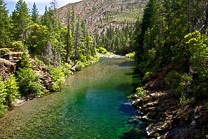Watershed
The Smith River Alliance Newsletter

Report from the River: Fall Chinook Return

Fish Counting Devices Installed
The DIDSON units use multiple beams of sonar to provide high quality images of the fish that pass through the beams. The units can spot fish up to 80 meters out into the river night and day.
“This is long overdue for the Smith River,” said Larson. “We need to know more about our populations of fish in order to be more targeted in the management for these species. We hope to gain insights about fish behavior and migration patterns — one pattern that we have observed is that Chinook seem to be migrating more at night.”
Individuals interested in making a financial contribution in support of this project can send a tax-deductible contribution to SRA and specify “DIDSON” on the check.

Mill Creek Restoration: Stabilizing Erosion Sites
A failed logging road or a plugged culvert that “blows out” can have catastrophic impacts on water quality, aquatic and riparian habitats, and salmon species — in the streams below these disasters. The impacts to fish and other aquatic species and their habitats can last for decades and sometimes much longer. For this reason, an aggressive erosion control and prevention program within the Mill Creek project area is underway to treat and stabilize the highest-risk sites which include miles of partially decommissioned and abandoned logging roads that are part of the former industrial timberland.
How much erosion has been prevented? Over 618,000 cubic yards of soil and debris that could have been delivered to down-slope and adjacent streams has been stabilized. That volume would fill 68,633 dump trucks — enough to cover the distance from Sacramento to LA, if those trucks were bumper to bumper!!! Nearly 50 miles of at-risk-of-failing logging road have been removed including hundreds of “landings” and old and undersized culverts. Dozens of other culverts have been replaced and a special winter storm patrol has been funded to monitor the existing road system and keep the ditches and culverts clear during the rainy season.
This multi-year effort is an excellent example of measurable progress in erosion prevention and control. This effort and others like it in the basin will protect and restore aquatic and riparian resources in the Smith’s most productive tributaries.
Funding and managing this massive field program has been an extraordinary team effort involving Redwood National and State Parks, DFG, the Wildlife Conservation Board, Coastal Conservancy, SRA and Save The Redwoods League. Thanks to our partners for working with us on this critically important habitat protection and restoration project. As your dentist will tell you, “An ounce of prevention is worth a pound of cure!”

Rock Creek Ranch News: A New Structure
The yurt is a modern adaptation of the ancient shelter used by Central Asian nomads for centuries. The compact shape and lightweight beams are a low-cost and modern version that retains the ancient form of nomadic tents of Mongolia, which were covered with animal skins.

Work Parties
Rock Creek Ranch depends on volunteer work parties to accomplish key projects throughout the year. In 2010 volunteers have built a new sleeping deck, erected the yurt, removed invasive plants and launched an initiative to fully restore the Majesty Pool overlook, damaged by high water a couple of years ago. Send us an email at info@smithriveralliance.org if you want to be notified of work projects and opportunities.
Help us Protect the Smith
Newsletters & Announcements
Donate to Smith River Alliance
Communities Stand Strong Against Strip Mining

Read some of the press and letters submitted in support of the proposed mineral withdrawal.
Learn more.
Experience the Smith

Clear waters, old-growth forests, salmon and bears... get to know the world famous Smith River and see where we work. Learn more.
